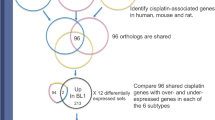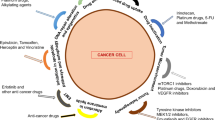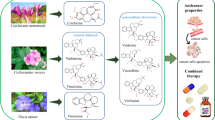Abstract.
Homoharringtonine (HHT) is an ester of cephalotaxine (CET), both of which derive from the Chinese coniferous tree Cephalotaxus hainanensis. HHT inhibited tumor cell growth at molar ranges comparable to established cytostatic drugs, whereas CET was 3–4 orders of magnitude less active. Inhibition concentration 50% (IC50) values of CET and HHT were significantly correlated to doxorubicin, vincristine, methotrexate, cisplatin, or camptothecin in 55 cell lines of the Developmental Therapeutics Program of the National Cancer Institute (NCI, Bethesda, Md., USA). We tested both drugs for resistance of cell lines which selectively overexpress the multidrug resistance (MDR)-conferring genes P-glycoprotein/MDR1 (CEM/ADR5000), MDR-related protein 1 MRP1 (HL60/AR), and breast cancer resistance protein BCRP (MDA-MB-231-BCRP). A threefold and ninefold resistance to HHT and CET, respectively, was found in CEM/ADR5000 cells, while the other MDR cell lines did not show cross-resistance compared to their drug-sensitive counterparts. As the tumor suppressor p53 is another important factor of chemoresistance, we also analyzed the possibility that p53 affects the response of tumor cells to CET and HHT. Comparing the p53 mutational status of the 55 NCI cell lines (http://dtp.nci.nih.gov) with the IC50 values showed a significant correlation. Thus, CET and HHT were more active in cell lines without p53 mutation. We correlated the IC50 values of CET and HHT with the cell doubling times of the 55 NCI cell lines as proliferation parameter and observed that rapidly growing cells were more susceptible than slowly growing cell lines. We conducted a search mining the NCI's database for the mRNA expression of 465 genes in 55 cell lines and correlated the data with the IC50 values for CET and HHT. Of these genes 61 (=13%) correlated with the IC50 values for CET and 122 (=26%) with the IC50 values for HHT indicating the multifactorial mode of action of these drugs in cancer cells. We have chosen one example from these genes to test a causative role for drug response. U-87MG.ΔEGFR cells transfected with an epidermal growth factor receptor (EGFR) gene truncated in its extracellular domain through a deletion of exons 2–7 (ΔEGFR) were 14-fold more resistant to HHT than control cells transfected with mock expression vector or non-transfected cells. The present investigation presents a starting point to dissect the genes and molecular pathways involved in the tumor cells' response to CET and HHT in greater detail.
Similar content being viewed by others
Author information
Authors and Affiliations
Additional information
Electronic Publication
Rights and permissions
About this article
Cite this article
Efferth, T., Sauerbrey, A., Halatsch, ME. et al. Molecular modes of action of cephalotaxine and homoharringtonine from the coniferous tree Cephalotaxus hainanensis in human tumor cell lines. Naunyn-Schmiedeberg's Arch Pharmacol 367, 56–67 (2003). https://doi.org/10.1007/s00210-002-0632-0
Received:
Accepted:
Issue Date:
DOI: https://doi.org/10.1007/s00210-002-0632-0




